Community-Based Restoration of Agroforestry Parklands in Kapelebyong District, North Eastern Uganda (SITR8-4)
17.03.2024
SUBMITTING ORGANIZATION
Save A Seed for the Future (SAFE)
DATE OF SUBMISSION
19/09/2023
REGION
Africa
COUNTRY
Uganda
AUTHOR(S)
Kizito Echiru
Samuel Ojelel
LINK
1 Introduction
In Uganda, 69% of households derive their livelihoods from subsistence farming (UBOS 2017). This reliance on agriculture coupled with a high population growth rate (3% per annum) has culminated in the clearance of natural landscapes. As a result, drylands (84,000 km2 , or 43% of the country), which have been identified as a Socio-ecological production landscape (SEPL) (Olupot 2015), have also been affected. According to Olupot (2015), this SEPL has undergone a large-scale conversion of land into agricultural farms and overexploitation of indigenous trees for wood fuel (charcoal and firewood). These human activities have resulted in the decimation of the traditional agroforestry parkland farming system (scattered trees in cultivated fields), a reduction in crop productivity, an increase in poverty, and the general degradation of environment (Olupot 2015). Common tree species include Mangifera indica, Vitellaria paradoxa, Tamarindus indica, and Combretum spp., among others. These are usually intercropped with millet, groundnuts, cowpeas, cassava, potatoes, rice, beans, maize, and green grams (Ojelel and Kakudidi 2015).
Trees play an integral part in the agroforestry parkland system by providing food, fuel, fodder, medicinal products, building materials, and saleable commodities, as well as contributing to the maintenance of soil fertility, water conservation, and environmental protection (Boffa 1999). Additionally, they contribute to improving the physical, biological, and chemical fertility characteristics of surrounding soils through a variety of processes. Data on the build-up of soil fertility and microclimate properties over the life of trees demonstrate that benefits are only realised over a long period. They also play a significant role in ensuring social equality, cultural stability, and spiritual values in traditional rural societies. More so, production of non-timber forest products in agroforestry parklands generates significant income for a variety of local economic actors. It, therefore, suffices to say that agroforestry parklands are pivotal in the attainment of the twin objectives of biodiversity conservation and sustainable livelihoods of communities. Owing to the importance of agroforestry parklands, Boffa (1999) opines that efforts to conserve and enrich existing parklands and to establish new ones are particularly critical.
This case study emanates from an action research project undertaken from 2019 to 2020 by Save a Seed for the Future (SAFE), Uganda (www.saveaseedforthefuture.org), with support from the Satoyama Development Mechanism (SDM). A baseline study was aimed at generating critical information regarding the reference ecosystem, a critical step in any restoration initiative. According to the Society for Ecological Restoration (SER), identifying a reference ecosystem is one of the eight principles of ecological restoration (Gann et al. 2019). The project targeted the sub-humid drylands of Kapelebyong District, Teso sub-region, where 91.9% of households are involved in subsistence crop farming (UBOS 2017). The project’s objectives were to: (1) document tree diversity and traditional knowledge in remnant agroforestry parklands, (2) enhance community awareness and knowledge on agroforestry parklands, and (3) restore indigenous trees on 1500 hectares of cultivated fields. The project envisaged that the trees planted would provide timber and fuelwood; improve soil fertility and control water runoff; improve nutrition with fruits, nuts, and leaves; boost household incomes; and enhance habitat suitability and connectivity for different faunal species. Accordingly, the project would lead to the revitalisation of the traditional agroforestry parkland farming system, which would subsequently promote biodiversity conservation and sustainable livelihoods in harmony with nature.
2 Materials and Methods
2.1 Study Area
The project was conducted in the sub-humid drylands of Kapelebyong District, northeastern Uganda between 33°30′E to 33° 45′E and 2°24’N to 2°45’N (Table 5.1 and Fig. 5.1). Vegetation is predominantly savannah, dominated by Combretum species, Vitalleria paradoxa, and punctuated by seasonal as well as permanent streams. The area experiences a humid and hot climate with 1000–1350 mm of annual rainfall and temperatures ranging from 18 to 31.3 °C (Egeru 2012). Likewise, households involved in livestock farming represent 86.5%. The overall proportion of the population dependent on subsistence farming as the main source of livelihood is 86.2% (UBOS 2017). Crops grown in this area include millet, rice, sorghum, cowpeas, groundnuts, green grams, cassava, and sweet potatoes (Ojelel and Kakudidi 2015). Livestock reared includes cattle, goats, and sheep, with farmers also relying on animal traction. The project activities were carried out in three of the seven sub-counties in Kapelebyong District, namely: Obalanga, Alito, and Okungur (https://kapelebyong.go.ug/lg/political-and-administrative-structure). The major tribes in this area are Iteso with small populations of Karamojong and Luo. The major ecosystems in the district include savannah woodlands, wetlands and river tributaries, and agricultural lands managed through private property, common property, and public property regimes. The district has two central forest reserves (public property), namely Akileng and Alungamosimosi, with the former located in Alito sub-county.
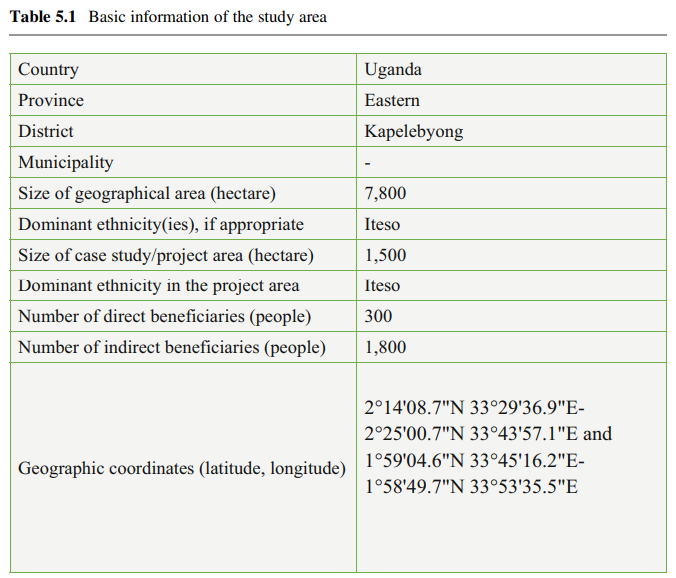
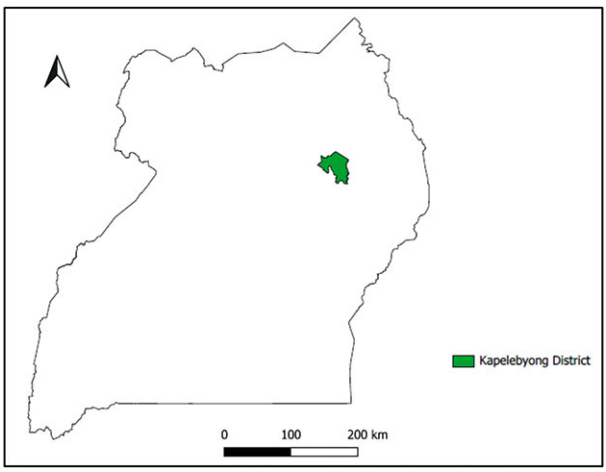
2.2 Implementation of Activities
Project activities commenced with a half-day stakeholder meeting on February 21, 2020, at Obalanga sub-county headquarters in the Kapelebyong District. Participants included among others District technical staff on natural resources, sub-county community development officers, parish chiefs, sub-county political leaders, representatives from the Iteso Cultural Union, and farmer group representatives (Fig. 5.2). The purpose of the meeting was to brief key stakeholders on project deliverables and to receive their feedback/insights. Thereafter, we commenced the botanical survey of tree species in the remnant agroforestry parklands with registered farmers as the target population. Twelve farmer groups were identified based on their interest in tree planting as expressed in their constitutions’ aims and objectives. Each of the registered groups at respective sub-county community development offices has between 25 and 30 members.
Then, we randomly identified five subsistence farmers from each of the 12 registered farmer groups in the sub-counties of Obalanga, Okungur, and Alito in Kapelebyong District (totalling 60). We adopted the farmer group approach to facilitate mobilisation and target key informants with a preexisting interest in tree planting. A meeting was arranged with the group chairpersons to brief them on the research objectives, and five members were randomly selected from each group and thereafter interviewed in their respective villages (homesteads). The village is the lowest administrative unit in Uganda under the local government structure. We administered a semi-structured questionnaire to each farmer in their field (parkland). The questionnaire elicited information on the number and identity of trees per hectare, source of knowledge on tree preservation or planting on farm, benefits derived from trees, management of trees, and modes of harvesting tree products. The interviews took place in the parklands to minimise chances of missing tree species currently present or mistakenly including those absent.
Additionally, we conducted community sensitisation meetings (328 female and 209 male participants), produced and distributed brochures, and held a radio talk show on the Teso Broadcasting Service (87.6 FM). The brochures contained vital information on the value of trees on farms, common species in the agroforestry parklands of Kapelebyong, and management of trees on farms, among other information. This educational component was aimed at raising community awareness on the importance of trees on farms and tree planting in general.
We assisted two farmer groups with nursery bed equipment (wheelbarrows, spades, watering cans, trowels, potting paper) and assorted tree seeds namely Grevillea robusta, Citrus sinensis, Psidium guajava, Eucalyptus camadulensis, and Markhamia lutea (Fig. 5.3). These groups also received a stipend to promote motivation for raising the tree seedlings for the project. The groups were continuously monitored and supported by our field staff to ensure successful management of the nurseries. When the seedlings were ready for transplanting, the farmers prepared their fields and received the seedlings after field staff had ascertained the state of their fields.
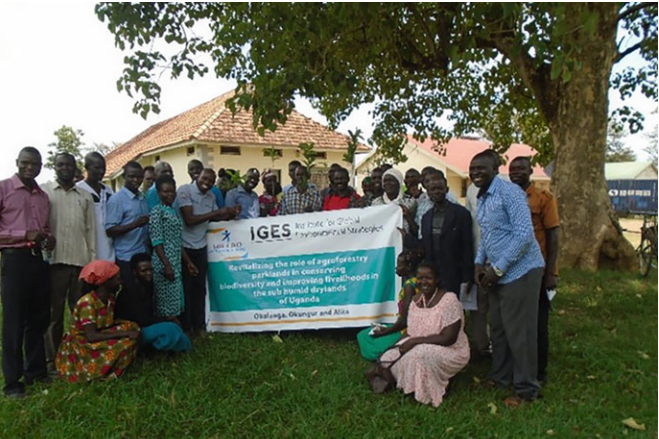
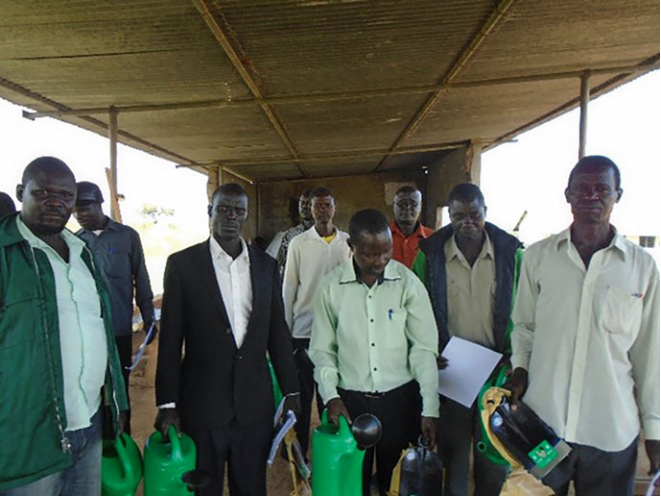
2.3 Data Analysis
We computed the diversity of tree species in the agroforestry parklands using the Shannon-Wiener index based on the formula:

where p is the proportion (n/N) of individuals of a particular species (n) divided by the total number of individuals (N), and s is the number of species. Shannon’s equitability (EH) was calculated following Krebs17 procedure, namely: dividing H by Hmax (here Hmax = lnS) using the formula:

Equitability assumes a value between 0 and 1 whereby 1 represents complete evenness. Means and percentages were used to analyse data on tree management strategies, tree harvesting techniques, and sources of knowledge on farm tree management. Graphs and tables were then used to present these results. The results of tree planting were analysed based on the survival rate of the seedlings distributed to the farmers and planted.
3 Results and Discussion
3.1 Documentation of Tree Species and Traditional Knowledge
3.1.1 Diversity of Tree Species
The study established an inventory of 43 tree species in 18 families in the agroforestry parklands of Kapelebyong District (Appendix 5.1). It was observed that only nine tree species (20.9%) were deliberately planted in the parklands, while the majority (79.1%) were retained when fields were first created. The species planted include Mangifera indica, Anacardium occidentale, Carica papaya, Azadirachta indica, Melia azedarach, Eucalyptus camaldulensis, Psidium guajava, Grevillea robusta, and Citrus sinensis. The planting of trees on cultivated fields increases species richness, diversity, and ecosystem services. A study by Buyinza et al. (2015) conducted among local communities in the Lake Kyoga basin recorded that the communities preferred preserving to planting trees on cultivated fields. This trend, however, contrasts with that reported in the agricultural landscapes of the Kigezi sub-region in western Uganda (Boffa et al. 2005). In the present case study, the weak tree planting ethos can be attributed to the perceived abundance of indigenous trees resulting in a lack of urgency to engage in tree planting.
The Shannon-Wiener diversity index of tree species in the agroforestry parklands of Kapelebyong is 3.23 with an equitability (evenness) of 0.86. This diversity index (H′ = 3.23) is greater than 2.0, which denotes high diversity (Magurran 2004). The high equitability index shows that tree species are evenly distributed in the parklands. The mean tree density in these parklands is 5.7 trees ha-1 . This density is lower than the 15–42 mature trees/ha previously reported in some districts of Uganda (Byakagaba et al. 2011). Prevalent species include Combretum adenogonium, Vitalleria paradoxa, Combretum collinum, and Mangifera indica (Fig. 5.4). The presence of trees in the parklands underscores their ability to enhance resilience to environmental calamities such as climate change (Reppin et al. 2020). Based on prevalent tree species (Boffa 1999), the parklands in Kapelebyong can be described as Combretum spp., and Vitalleria paradoxa parklands.
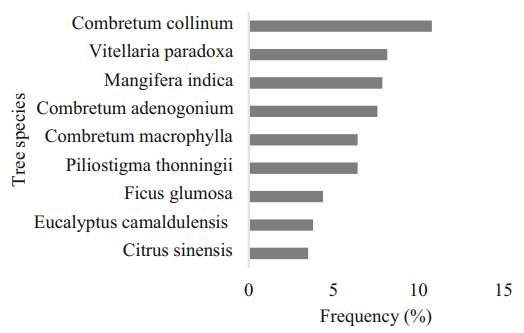
Almost all tree species in these parklands are indigenous or naturalised. Only Eucalyptus camaldulensis and Grevillea robusta species were exotic species encountered. This trend emanates from the limited availability of exotic tree planting materials and the poor tree planting culture. The latter stems from the perceived relative abundance of indigenous trees and their associated products. However, elsewhere it has been reported that 69% of the species planted in Kigezi, western Uganda, were exotic (Boffa et al. 2005).
3.1.2 Uses of Parkland Trees
The farmers reported diverse uses of trees in the parklands (Fig. 5.5). The tree species provided 24 use categories with the greatest number of species contributing to provisioning services such as firewood, timber, and fruits (Fig. 5.5). This highlights the dependence of the community on the parklands as a livelihood buffer (Boffa 1999; Buyinza et al. 2015). In Burkina Faso, the carbon payment system promoted by the Reducing Emissions from Deforestation and Forest Degradation (REDD+) initiative is profitable for smallholder farmers who make efforts to plant and keep trees on farms (Neya et al. 2020). However, this programme is still in its infancy and has yet to benefit many smallholder farmers in Uganda. This signifies that parkland trees are exploited for their consumptive use value. This could be a precursor for non-renewability once demand exceeds supply.
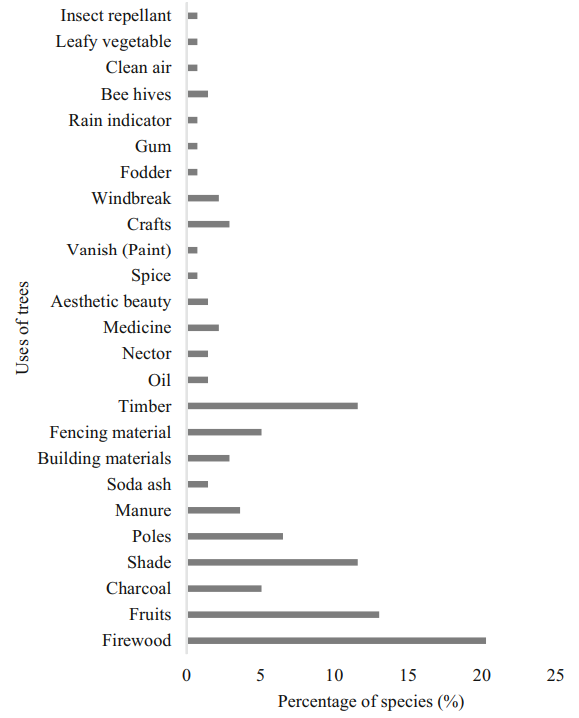
3.1.3 Knowledge of Preserving Trees in Parklands
Knowledge of preserving and/or planting trees on farms was acquired in many ways (Fig. 5.6). Most farmers learnt by imitating what their parents did when creating and managing crop fields. Knowledge was thus found to be passed from one generation to another through practical hands-on experience. However, given the increasing rate of urbanisation coupled with rural–urban migration, especially among the youths, it is feared that this transfer of knowledge will be increasingly impeded. The case study, therefore, makes a significant step towards ensuring the integration of traditional knowledge to provide prescriptions that are relevant to present scenarios. Figure 5.6 also shows that more farmers preserve trees on farmlands because of their own initiative and after trainings, aside from being obligated to do so according to by-laws. This provides a fundamental lesson to environmental practitioners to always prioritise awareness and sensitisation to create a change in the attitude of the target community. This data implies that people will protect species or ecosystems that are valuable to their livelihoods without necessarily being obligated to uphold laws. Therefore, these results affirm the assertion that “farmers are rational decision makers who choose to conserve and regenerate trees in their fields if this brings higher benefits” (Boffa 1999). The findings are akin to the policy mix approach whereby a combination of policy instruments that have evolved over time influence the quantity and quality of biodiversity conservation and ecosystem service provision (Ring and Schröter-Schlaack 2011).
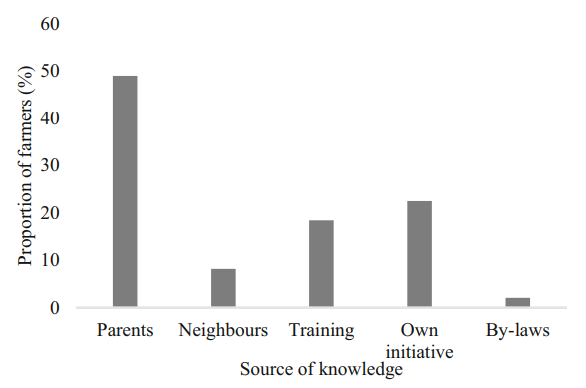
3.1.4 Tree Management Techniques
The study documented three major tree management techniques, shown in Fig. 5.7. Weeding and pruning are the prevalent tree management practices in the parklands of Kapelebyong District (Fig. 5.7). Weeding is applied to control weeds when crops such as finger millet, ground nuts, and cowpeas are in the field, while pruning can be done with or without crops. Tree management through pruning offers twofold benefits: first, it reduces shade thus minimising tree competition with crops; and secondly, it provides harvestable materials such as firewood and construction materials, among others. Other tree management measures include spraying with insecticides (although not environmentally friendly), watering during the dry season, application of manure, coppicing, and pollarding. In West Africa, tree pruning is an attractive option to improve crop production around tree canopies (Boffa 1999). Pollarding was not reported as a major tree management technique within the parklands of Kapelebyong. This can be attributed to limited use of parkland trees as fodder. According to Soule (1985), pollarding is carried out repeatedly by pruning branches at or near the same point, which results in the distinctive thick bushy appearance of the trees and is used for easing access for livestock, among other uses.
The tree management techniques aim at optimising the productivity of the parklands in terms of tree products and crop produce. The resultant benefits in turn act as an incentive for the farmers to engage in restoration of the parklands. As stated by Hemida and Adam (2019), effective management of trees on farms (parklands) acts as a key livelihood strategy to increase and diversify income sources and strengthens farmers’ ability to improve their livelihoods. Thus, tree management techniques are applied according to the needs of the farmers.
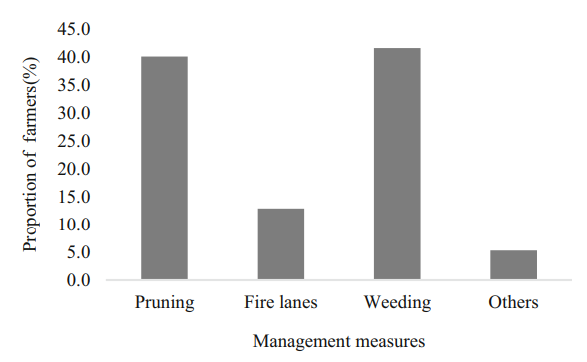
3.1.5 Harvesting Techniques
We recorded six techniques applied to harvesting trees and tree products in the parklands of Kapelebyong District (Fig. 5.8). The most prevalent method is pruning (especially of branches and twigs) while debarking is the least applied. The low prevalence of debarking and digging roots points to the prudence of farmers and limited knowledge on the use of tree barks and roots. This demonstrates that farmers are judicious when harvesting trees on their farms. It also points to an in-built culture of ensuring sustainable use of the available resource. Buyinza et al. (2015) opine that the most important species will suffer the greatest harvesting pressure from local communities. The harvesting techniques documented in this case study could pose variable effects on the trees depending on the parts harvested. For example, harvesting of fruits has been reported to cause a significant impact on regeneration and population viability (Gaoue and Ticktin 2008 cited in Delvaux et al. 2009) while harvesting of the bark or roots lessens tree survival (Vermeulen 2006, Delvaux et al. 2009). Therefore, a prerequisite for sustainable management of agroforestry trees is knowledge on the response of species to harvesting techniques. However, the current study did not investigate the differential impacts of harvesting for each tree species recorded in the parklands.

2 Raising Community Awareness on Agroforestry Parklands
We held five community sensitisation meetings, distributed brochures, and broadcast a radio talk show on 89.7 FM Teso Broadcasting Service to raise community awareness on the value of agroforestry parklands. The meetings reached out to 537 (328 females and 209 males) participants in the sub-counties of Alito, Obalanga, and Okungur. Awareness motivates farmers and deepens their knowledge and understanding of the importance of agroforestry parklands. As observed by Tesfaye et al. (2014), it also influences farmers’ decision-making on conservation actions.
3 Restoring Tree Cover in Cultivated Fields
We distributed at least 14,500 tree seedlings to 300 farmers in the 12 groups for planting on their individual farms (Figs. 5.9 and 5.10). At the time of project closure, the survival rate was 75% (10,875). Factors affecting this survival rate include destruction by termites and stray livestock, especially goats, and erratic rains. It was evident that farmers with large pieces of land opted to dedicate their fields to tree planting in the form of plantations and woodlots rather than agroforestry parklands. Trees planted were Grevillea robusta, Citrus sinensis, Psidium guajava, Eucalyptus camadulensis, and Markhamia lutea. These species were selected due to their adaptability to local environmental conditions, agroforestry value such as having open crowns for light penetration, multi-purpose production capacity (timber, firewood, fruits), fast growth rates, and acceptability among farmers. Although the project aimed to restore indigenous species, this could not be fully achieved due to scarcity of planting material and slow growth rates. Cognisant of these obstacles, we reached a compromise to utilise both native and exotic tree species, provided they met the criteria explained earlier.
The success of the restoration efforts can be monitored in several ways. First, there is a need for continuous field monitoring and support visits by the implementing agencies, local government extension workers, and funding agencies. This would help to bridge technical gaps as well as recommend any corrective actions that need to be undertaken. Secondly, the stakeholders can conduct joint evaluations of the progress and achievements of the restoration efforts using prior determined indicators such as tree survival rates. Thus, every restoration project ought to have an elaborate results-based strategy for monitoring and evaluation of its impacts.
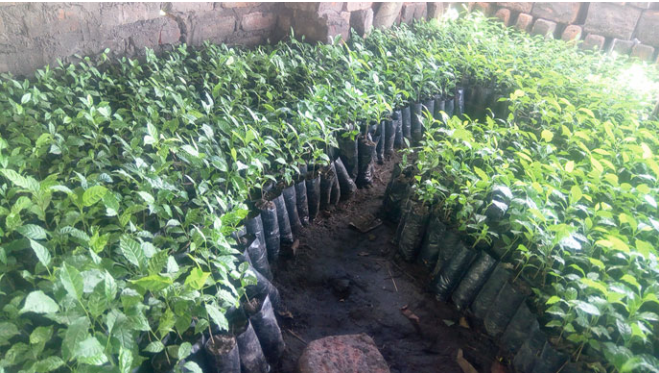
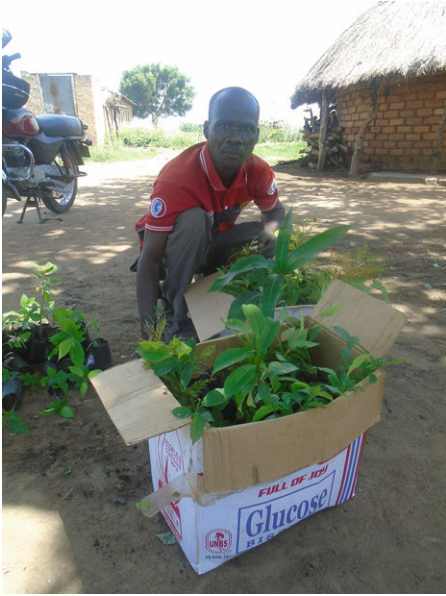
4 Conclusion, Lessons, Challenges, Opportunities, and Recommendations
4.1 Conclusions
This study recorded 43 tree species in the parklands in Kapelebyong District with a high species diversity index and evenness. The trees provide diverse products to the farmers. Most of the trees are indigenous species preserved during opening of the land. The project raised community awareness, which was instrumental in enhancing community knowledge on agroforestry parklands and participation in raising and planting at least 14,500 tree seedlings in their farmlands towards restoring agroforestry parklands. The engagement of the community in prioritisation of the tree species and participation in raising seedlings allowed the community to take ownership of the restoration initiative.
4.2 Lessons, Challenges, and Opportunities
The lessons learnt during execution of this project include the following: (1) the community willingness to restore what is beneficial to their livelihoods (local relevance of restoration or any other interventions); (2) the importance of traditional knowledge in developing reference (baseline) information, for example, species lists, upon which restoration activities can be anchored; (3) the need to strike a win-win situation when choosing between native and exotic tree species to be prioritised in restoration initiatives; and (4) the need to take advantage of the environmental challenges and resource scarcity facing communities to create opportunities for garnering support for restoration.
We could not meet the demands and aspirations of the entire community in Kapelebyong District due to the small resources at our disposal. The UN (2019) opined that ecosystem restoration is costly in terms of time and financial resources with approximately 2000 USD required to restore 1 hectare (UN 2019). We also faced the challenge of finding and raising indigenous tree seedlings. In fact, there is a knowledge gap on this matter at the national level. This gap is partly responsible for the preference of exotic over native tree species in tree planting initiatives (Kalema and Hamilton 2020). Additionally, we faced challenges from unpredictable weather patterns (droughts and rains), insects (especially termites), and stray livestock (mostly goats and cattle), which destroy tree seedlings thereby reducing the survival rates. Another challenge encountered centred on indigenous versus exotic tree species. The farmers tend to prefer the latter due to their fast growth as opposed to the former. Additionally, the continued dependence on biomass energy (firewood and charcoal) is a serious impediment to restoration efforts.
The restoration of ecosystems can benefit from increasing environmental awareness and cautiousness in the community. This is occasioned by the visible scarcity of valuable resources such as firewood, timber, construction materials, and so forth. Environmental practitioners can galvanise support around scarcity of vital resources to rally communities to undertake ecosystem restoration. Globalisation has also accelerated information sharing, networking, and collaboration, which can be harnessed to design and implement ecosystem restoration projects. Additionally, there are national and international commitments and declarations for the UN Decade on Ecosystem Restoration 2021–2030 (UN 2019), which can help to mobilise support and financial resources for ecosystem restoration projects. There are also funding agencies offering funding on a competitive basis for projects geared towards ecosystem restoration, for example, the Global Environment Facility (GEF).
4.3 Recommendations
Basing on the experience from this case study, we recommend the following:
- The knowledge gap regarding the propagation of native tree species needs to be filled to avail indigenous tree seedlings in a timely manner.
- There is a need to sensitise the populace on the benefits of native tree species over exotic species, but a combination of the two may be a more realistic option.
- There is a need to put in place measures that ameliorate factors that decrease tree survival rates, for example, adoption of environmentally friendly anti-termite measures, soil moisture conservation measures such as mulching during dry spells and limiting the movement of stray livestock.
- There is a need to understand the impacts of different tree harvesting techniques on regeneration, population viability, and tree survival in agroforestry parklands.
- There is a need to scale up the restoration of agroforestry parklands in the drylands of Uganda to optimise the twin objectives of biodiversity conservation and sustainable livelihoods.
Acknowledgements We extend our gratitude to the Institute for Global Environmental Strategies (IGES) through the Satoyama Development Mechanism (SDM) for the financial support towards the implementation of this project. We are also grateful to the local government staff and the farmers in the Kapelebyong District who actively participated during the conceptualisation and implementation of the project.
Appendix 1 Agroforestry parkland tree species and their uses in Kapelebyong District, Uganda
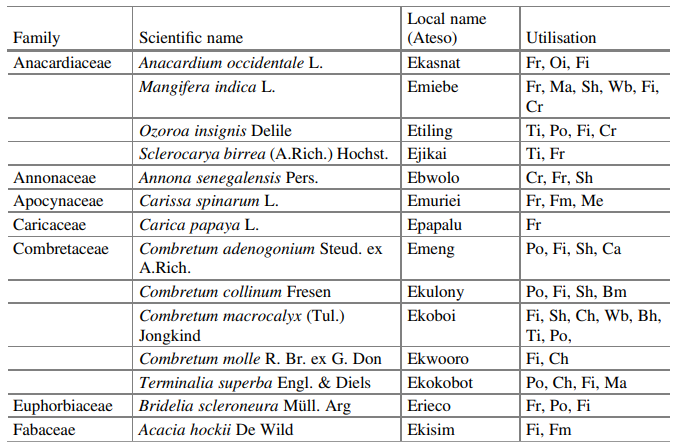

KEY: Fi Firewood, Fr Fruits, Ch Charcoal, Sh Shade, Po Poles, Ma Manure, Sa Soda ash, Bm Building materials, Fm Fencing materials, Ti Timber, Oi Oil, Ne Nector, Me edicine, Ab Aesthetic beauty, Sp Spice, Pa Paint for fish nets, Cr Crafts, Wb Windbreak, Fo Fodder, Gu Gum, Ra Rain indicator, Ca Clean air, Lv Leafy vegetable, Ir Insect repellent
Source: Echiru and Ojelel, 2019
Source: Echiru and Ojelel 2021
References
Boffa JM (1999) Agroforestry parklands in sub Saharan Africa. In: FAO conservation guide 34. Food and Agriculture Organization of the United Nations, Rome
Boffa JM, Turyomurugyendo L, Barnekow-Lillesø JP, Kindt R (2005) Enhancing farm tree diversity as a means of conserving landscape-based biodiversity. Mt Res Dev 25(3):212–217
Buyinza J, Agaba H, Ongodia G, Eryau K, Sekatuba J, Kalanzi F, Kwaga P, Mudondo S, Nansereko S (2015) On-farm conservation and use values of indigenous trees species in Uganda. Res J Agric Forestry Sci 3(3):19–25
Byakagaba P, Eilu G, Okullo JBL, Tumwebase SB, Mwavu EN (2011) Population structure and regeneration status of Vitellaria paradoxa (C.F. Gaertn.) under different land management regimes in Uganda. Agric J 6(1):14–22
Delvaux C, Sinsin B, Darchambeau F, Van Damme P (2009) Recovery from bark harvesting of 12 medicinal tree species in Benin, West Africa. J Appl Ecol 46(3):703–712
Echiru K, Ojelel S (2021) Utilization and population structure of tree species in the agroforestry parklands of Kapelebyong District, north eastern Uganda. Res J Agric Forestry Sci 9(3):1–8
Egeru A (2012) Role of indigenous knowledge in climate change adaptation: a case study of the Teso sub-region, eastern Uganda. Indian J Tradit Knowl 11(2):217–224
Gann GD, McDonald T, Walder B, Aronson J, Nelson CR, Jonson J et al (2019) International principles and standards for the practice of ecological restoration. Restor Ecol 27(S1):S1–S46
Gaoue OG, Ticktin T (2008) Impacts of bark and foliage harvest on Khaya senegalensis (Meliaceae) reproductive performance in Benin. J Appl Ecol 45(1):34–40
Hemida MAA, Adam YO (2019) The importance of farm trees in rural livelihoods in eastern Galabat locality, Sudan. Agric Forestry J 3(2):81–88
Kalema J, Hamilton A (2020) Field guide to the forest trees of Uganda: for identification and conservation. CABI
Magurran AE (2004) Measuring biological diversity. Blackwell, Oxford
Neya T, Abunyewa AA, Neya O, Zoungrana BJ, Dimobe K, Tiendrebeogo H, Magistro J (2020) Carbon sequestration potential and marketable carbon value of smallholder agroforestry parklands across climatic zones of Burkina Faso: current status and way forward for REDD+ implementation. Environ Manag 65:203–211
Ojelel S, Kakudidi EK (2015) Wild edible plant species utilized by a subsistence farming community in Obalanga sub-county, Amuria District, Uganda. J Ethnobiol Ethnomed 11(1):7
Olupot W (2015) SEPLS definition and issues – a case of Uganda’s drylands. In: UNU-IAS & IGES (ed) Enhancing knowledge for better management of socio-ecological production landscapes and seascapes (SEPLS), Satoyama initiative thematic review, vol 1, pp 79–89
Reppin S, Kuyah S, de Neergaard A, Oelofse M, Rosenstock TS (2020) Contribution of agroforestry to climate change mitigation and livelihoods in Western Kenya. Agrofor Syst 94(1): 203–220
Ring I, Schröter-Schlaack C (2011) Instrument mixes for biodiversity policies. Helmholtz Centre for Environmental Research
Soule J (1985) Glossary for horticultural crops. John Wiley and Sons
Tesfaye A, Negatu W, Brouwer R, Van der Zaag P (2014) Understanding soil conservation decision of farmers in the Gedeb watershed, Ethiopia. Land Degrad Develop 25(1):71–79
Uganda Bureau of Statistics (UBOS) (2017) The national population and housing census 2014: area specific profile series, Kampala, Uganda
United Nations (2019) The United Nations Decade on Ecosystem Restoration, viewed 30 May 2022. Retrieved from https://wedocs.unep.org/bitstream/handle/20.500.11822/31813/ERDStrat.pdf?sequence=1&isAllowed=y
Note
The opinions expressed in this chapter are those of the author(s) and do not necessarily reflect the views of UNU-IAS, its Board of Directors, or the countries they represent.
Open Access This chapter is licenced under the terms of the Creative Commons AttributionNonCommercial-ShareAlike 3.0 IGO licence (http://creativecommons.org/licenses/by-nc-sa/3.0/ igo/), which permits any noncommercial use, sharing, adaptation, distribution and reproduction in any medium or format, as long as you give appropriate credit to UNU-IAS, provide a link to the Creative Commons licence and indicate if changes were made. If you remix, transform, or build upon this book or a part thereof, you must distribute your contributions under the same licence as the original. The use of the UNU-IAS name and logo, shall be subject to a separate written licence agreement between UNU-IAS and the user and is not authorised as part of this CC BY-NC-SA 3.0 IGO licence. Note that the link provided above includes additional terms and conditions of the licence.
The images or other third party material in this chapter are included in the chapter’s Creative Commons licence, unless indicated otherwise in a credit line to the material. If material is not included in the chapter’s Creative Commons licence and your intended use is not permitted by statutory regulation or exceeds the permitted use, you will need to obtain permission directly from
the copyright holder.

